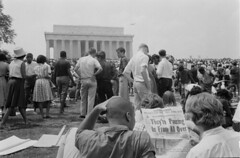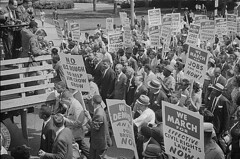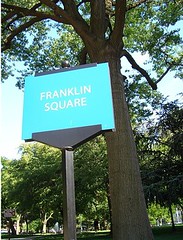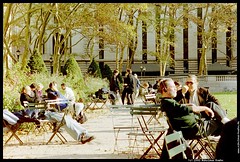National Mall Planning Process as an opportunity
--------
Point 7 revised with updated information provided by Cableflame. Thank you!
--------
I am too busy to produce a full write up of yesterday's conference on the National Mall planning process. Many people brought up great points. In a surprise to me, both Delegate Norton and Mayor Williams had important things to say about the National Mall, why Congress doesn't care about the National Mall, and the value and importance of the public realm. (I will write about this in more depth later.)
But here are some quick thoughts.
I was quoted in the Examiner, "What people want on the National Mall: Access," and the Washington Times, "Tips for a better Mall" about the new NPS initiative to plan the National Mall for the next generation. My quotes focused more on the visitor experience than the big picture, "forest vs. the trees" broader vision that I am known for... Yet don't think that's the only thing I'm thinking about.
• First, this planning process needs to be thought of in two very different ways or levels; (1) the visitor experience; and (2) the big overarching vision of where to we go from here, in the vein of the McMillan Commission, and the Legacy Plan (framework plan for Washington's Monumental Core, Extending the Legacy: Planning America’s Capital for the 21st Century) from the National Capital Planning Commission, as well as the role of the Mall as a national sacred space and place to practice democracy.

 LC Photos. U.S. News & World Report Magazine, Warren K. Leffler.
LC Photos. U.S. News & World Report Magazine, Warren K. Leffler.We need to do both. Simultaneously. And in depth.
• Second, like most planning processes, the vision and role of citizens is circumscribed. It's especially circumscribed here because as a federal agency, as great as the National Park Service is, it's less accustomed to having to answer to citizens/residents, more accustomed to dealing with their Executive Branch overseers and Congress.
A great resource that the National Park Service has created in the past, growing out of difficult interpretation issues at other sites, is the report National Park Service & Civic Engagement. The findings here need to be brought into this process. There is a big difference between consulting citizens and engaging citizens. (More about this later too.)
• Third, since this is an urban park, and one particularly important to the city and region, it is especially important that local citizens be engaged in the process, and able to think "outside the box." As I mentioned to one of the panelists, Kym Murphy, a retired Disney Corporation official, the size of the box of "allowed thinking" is much smaller on the part of the NPS than it is for those outside of NPS.
I seem to recall hearing statistics presented by John Parsons, Associate Regional Director for Lands, Resources, and Planning, for the National Capitol Region of NPS (he sits on the DC Zoning Commission also), at a presentation at the National Building Museum as much as 6 years ago, that 80% of the visitors to the National Mall are from DC, Maryland, and Virginia.
Resources for learning about parks and best practices include:
-- The Excellent City Park System: What Makes it Great, and How to Get There report from the Trust for Public Land;
-- The resources available from the City Parks Forum project of the American Planning Association;
-- The resources on Parks, Plazas, and Squares from the Project for Public Spaces including the paper, "Six Parks We Can All Learn From."
• Fourth, successful urban parks have constituency groups such as the Central Parks Conservancy. It's much harder to do this with federal parks, but a Trust for the National Mall has been created. Interestingly, it's a major "diss" of Judy Scott-Feldman, the creator of the National Coalition to Save the Mall, and whose efforts over the past few years including a series of conferences in 2004 brought this issue to the fore, has been sidestepped by the creation of the federally-sanctioned Trust for the National Mall, headed up by major developer and member of the local Growth Machine elite Federal City Council, Chip Akridge.
• Fifth, we need to extend the conversation about making the National Mall a "better park" to other NPS parks in the District of Columbia, those beyond the National Mall. Many of us clamor for being able to do more "Bryant Park-like" interventions--adding food service, places to sit, and other accoutrements, but NPS rules don't allow this. In fact, everyone who eats in parks such as McPherson Square, Farragut Square, and Dupont Circle are breaking the law.
 Franklin Square in DC. Flickr photo by Smile Hello Kitty.
Franklin Square in DC. Flickr photo by Smile Hello Kitty.For example, Franklin Park is a tremendous asset barely used. Think what it could be if it were able to be managed more like Bryant Park. And that's just one problem we face, having the control of such a great asset in the hands of the relatively distant from local concerns federal government.
 Photo of Bryant Park from the Project for Public Spaces.
Photo of Bryant Park from the Project for Public Spaces.• Sixth, we need to extend the conversation about making the National Mall a "better experience" to the visitor experience beyond the Mall. We as DC residents, citizens, and professionals need to step up and think about the same issues as they relate to the rest of the city. Places that are great for residents are also attractive to visitors! But there is no reason why we can't be professional and use destination assessment and management principles and processes to first help ourselves!
Some good resources for thinking about this are:
-- Tourism Destination Assessment Workbook;
-- the excellent book Tourist Destination Management: Issues, analysis and policies;
-- and this new piece from the Center for Park Management, produced for the National Mall planning process, entitled "Best Management Practices Summary." When the full report is available I am going to work to get it released. It has important findings that are relevant for destination management more generally.
• Seventh, we need to have more and serious discussion about the transportation issues around the National Mall. Part of the reason that the Tourmobile is the preferred service is that most of the concessionaire fees go to fund maintenance and improvement in local NPS installations--they need and want this money because they are underfunded. But making people pay $20 to get around is unreasonable. (See the NPS study, National Capital Parks - DC Visitor Transportation Study.)
The National Mall service provided during tourist season by the Downtown Circulator is a good idea, although it is very difficult to market because tourists are different everyday, and require constant marketing without the benefit of repeat sales.

There is a need to provide low-cost transportation service to the more western parts of the Mall, beyond the Washington Monument, which is the endpoint of the Circulator service, to the Jefferson Memorial, Lincoln Memorial, Vietnam Veterans Memorial, World War II Memorial, etc. And as a number of people commented, the people visiting many of these places are getting older and need/appreciate transportation assistance.
• Finally, we should take this energy and initiative and apply it to bringing best practices and light to bear on DC's own Department of Parks and Recreation. Click here for the DPR Master Planning Process website.
Index Keywords: urban-design-placemaking; parks



0 Comments:
Post a Comment
<< Home